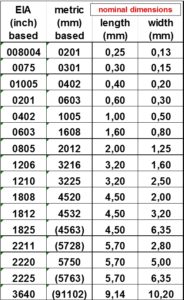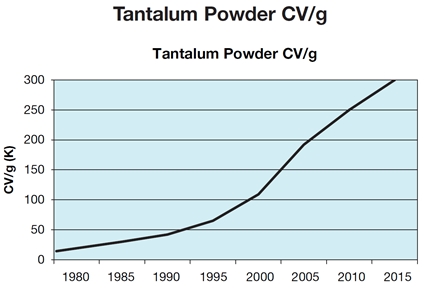Jürgen Geier, Christian Kasper, Jochen Neller, Bert Weiss
Rutronik
Passive electronic components are getting smaller, but the are also providing better performance within the same form factor. Twenty years ago form factors such as 1812 and 1206 were widely used. Today’s most commonly specified sizes are 0603 and 0402. The range extends down to 01005 (0.4 x 0.2 mm), and recently even to just 008004 (0.25 x 0.125 mm!).


The trend in SMD (surface mount device) resistors is also toward ever smaller form factors. Wired components are being replaced by this technology wherever possible. The 0201, 01005 and smaller form factors are used primarily in the mobile communications and tablet markets. Resistor networks – multiple resistors in one housing – also save space on the PCB. And high-power variants deliver twice the performance with the same housing form factor. Further miniaturization is taking place in the SMD current-measuring-resistor segment. New manufacturing technologies are enabling higher load capacities within the same form factor.
The form factors of tantalum capacitors – generally among the larger components – have diminished to such an extent over the last 20 years that they now take up only around 25% of the space they originally occupied on the PCB. Continual improvements in raw materials, smart component design and new manufacturing technologies have boosted volume efficiency in recent years.

Improvements in energy density of tantalum powder can only arise through continual development of powder grain size and properties. So the capacitance-to-voltage ratio per gram of tantalum powder (CV/g) is rising.
By optimizing the aluminum foil and the electrolyte used, for example, manufacturers can boost the capacitance while retaining the same form factor, while also extending service life many times over.

It should be noted also that such miniaturization does not necessarily lead to lower technical values in terms of ESR and ripple current. It is even possible to improve those values. So it is a good idea to keep a close watch on the latest developments in electrolytic capacitors because there are advances in the field happening regularly.



In the case of inductors, it might seem difficult to combine a high inductance with low dc resistance and small volume. Yet innovations such as improved multilayer and remolding technologies are making this possible today. A thin-film high-frequency inductor was recently launched featuring the ultra-miniature dimensions of 0.25 x 0.125 mm (008004), yet with the same quality grade Q as the larger form factor 01005 series.

Quartz dimensions of 3.2 x 2.5 mm are standard, though significantly smaller form factors such as 2.0 x 1.6 mm are already in wide use. Some manufacturers recommend accommodating 2016 sizes on 3225-size PCB pads. This does not necessarily mean the layout must be changed.
For quartz oscillators, MEMS technology and optimize chip design enable the quartz element and the resonant circuit to sit in ultra-miniature housings. As well as saving space, this combination also resolves accuracy and quality problems.
Real-time clocks (RTCs) in 3.2 x 2.5 x 1.0-mm packages are also available featuring extremely low current consumption. They are especially interesting for mobile, battery-powered applications.
Smaller components demand more precise and complex manufacturing techniques, in both fabrication and processing. A further aspect of the smallest form factors is that they are mostly more expensive than the larger sizes used in high volumes.
Below a certain size, the smallest form factors can no longer be replaced when in need of repair, and must be discarded along with the PCB. This can result in more production rejects and electronic scrap in the event of a fault.
Smaller – and so more densely packed – PCBs require more stringent protection against ESD, electromagnetic interference, and thermal problems. They often need more interference suppression components. At the same time, small form factors may help suppress interference because they can sit at the source of the interference or load site, reducing unwanted parasitics such as leakage inductance or stray capacitance.
Miniaturization also delivers lighter weight, less of a need for storage areas, and – not least – savings on raw materials. So the trend toward miniaturization is bound to continue.
